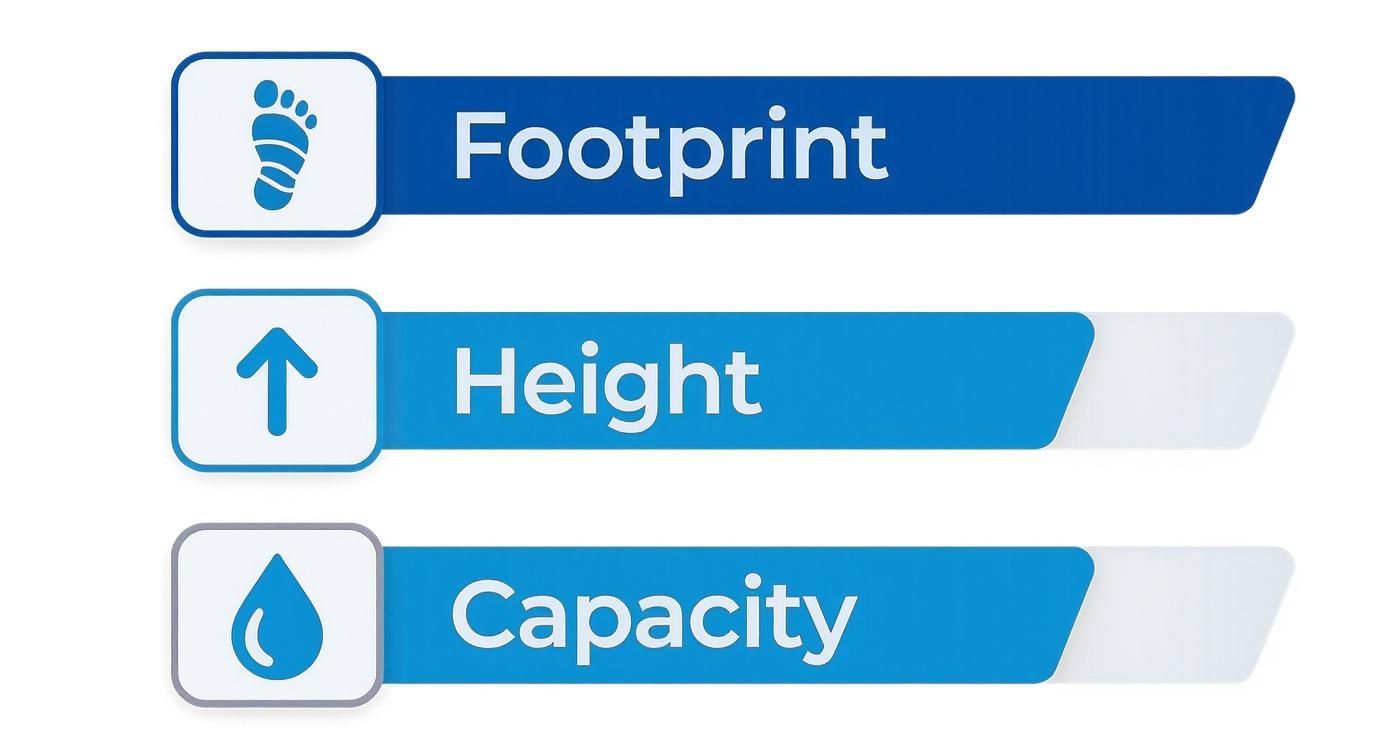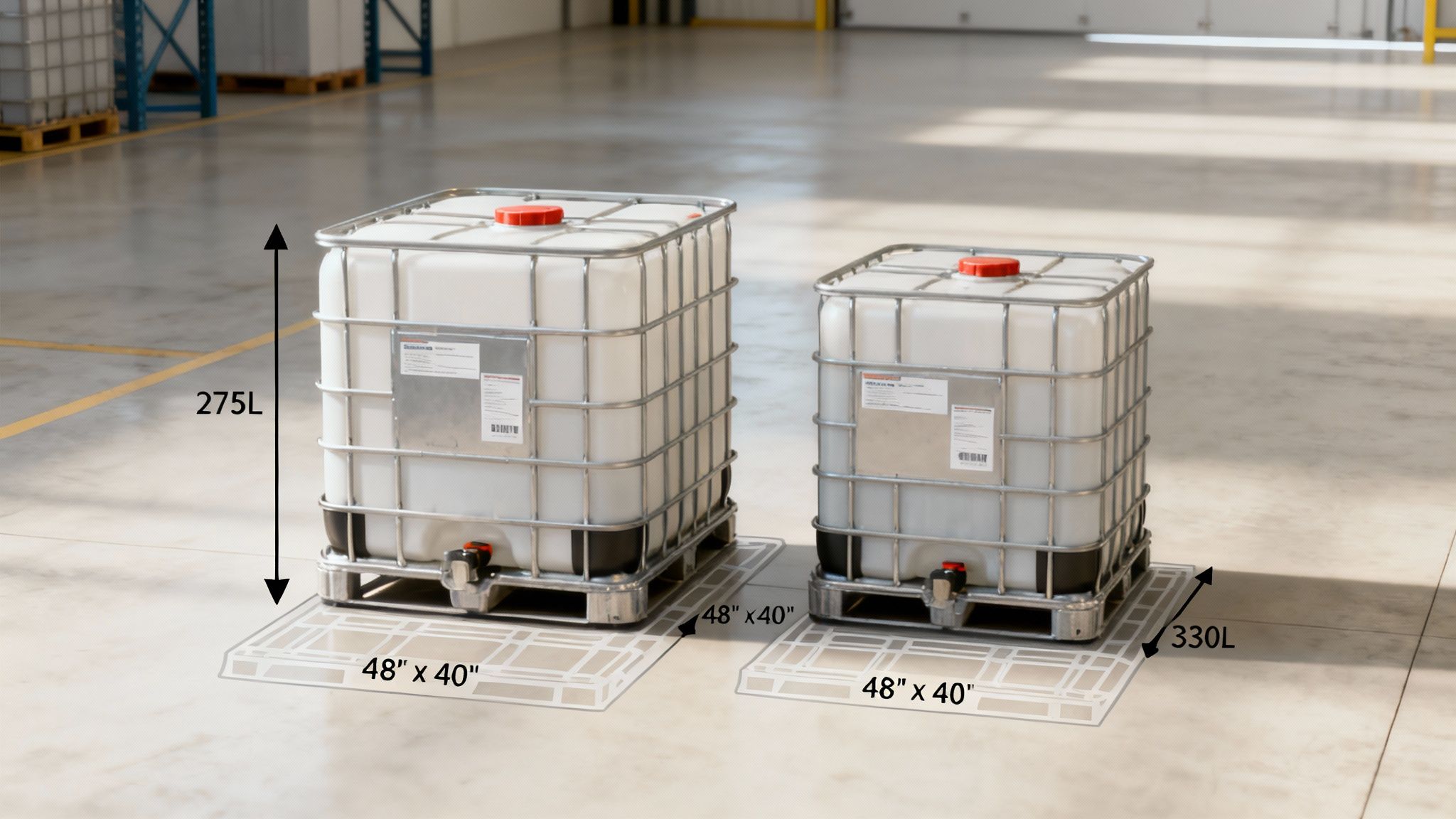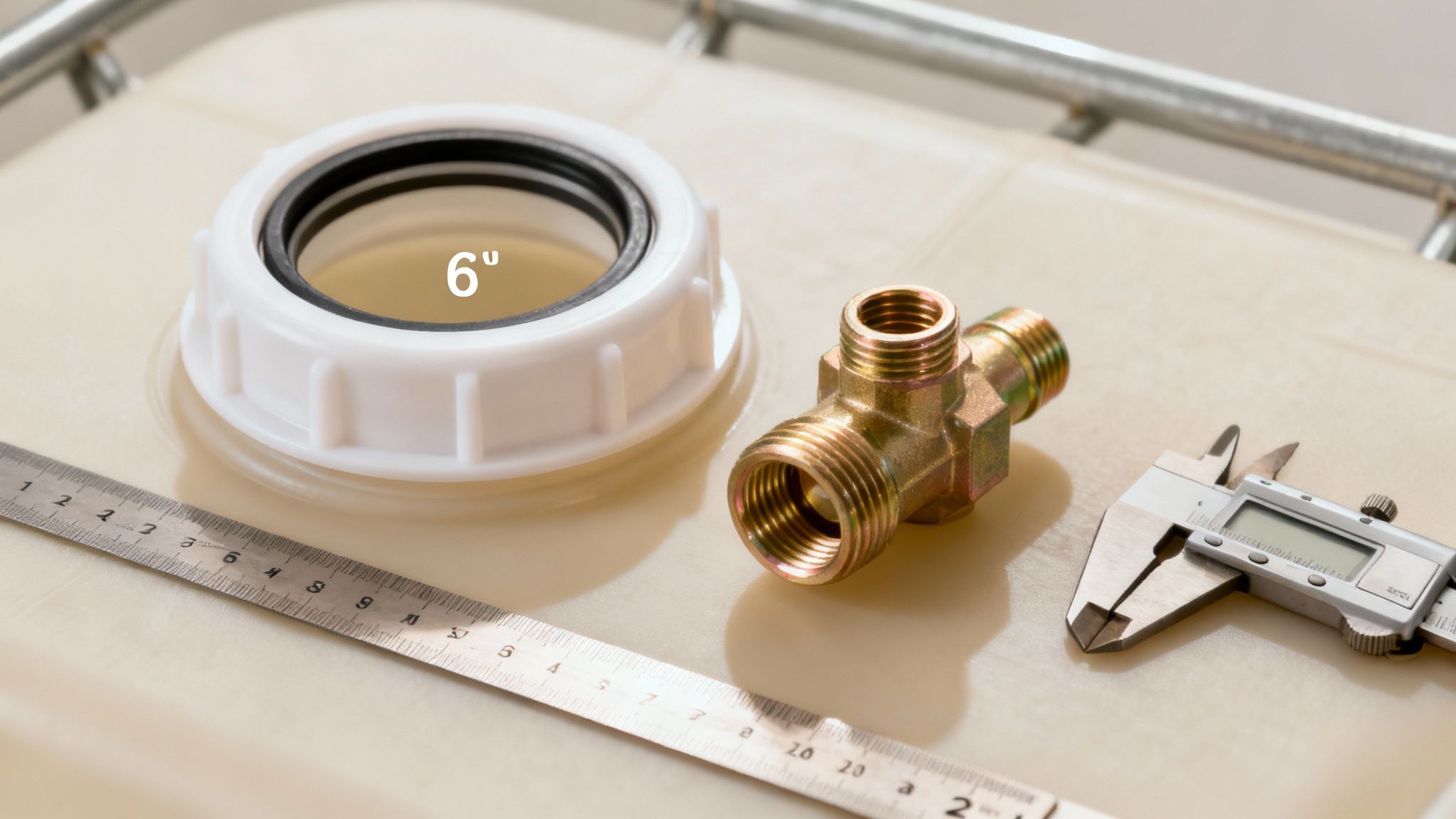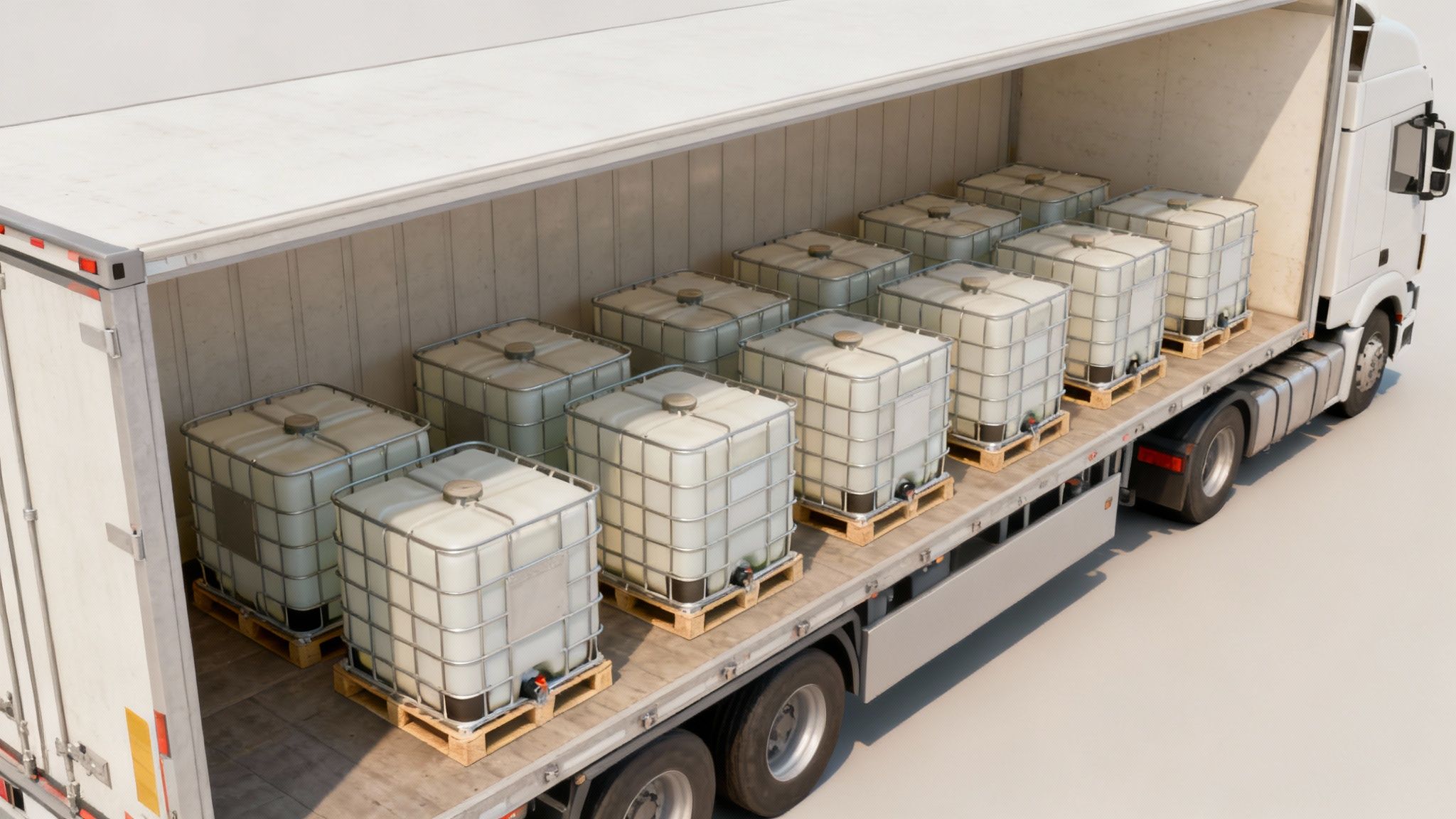Your cart is currently empty!
Tag: dimensions of ibc tote
-

Dimensions of ibc tote: Key measurements & specs
If you're planning your facility's layout, figuring out shipping logistics, or even just making sure a new piece of equipment will fit, you have to know the exact dimensions of your IBC totes. The two sizes you’ll run into most often are the 275-gallon and 330-gallon totes. They share a standard footprint, but their height is the key difference, which has a big impact on how you can store and transport them.
A Quick Guide to IBC Tote Dimensions
It really helps to have the core specs handy when you're making quick decisions. The main thing to remember is that while the 275 and 330-gallon IBCs have nearly identical bases to fit standard pallet systems, the 330-gallon model stands noticeably taller to hold that extra volume. This is a critical detail for everything from warehouse racking heights and stacking limits to ensuring you have enough clearance in your transport vehicles.
The infographic below gives you a great visual comparison of the footprint, height, and capacity of these common totes.

As you can see, the length and width are consistent, making that height difference the one to watch.
For a more detailed breakdown, the table below summarizes the key measurements and specifications for these industry workhorses. Keep this handy for accurate logistical planning to make sure your space and equipment line up perfectly with the totes you're using.
Standard IBC Tote Dimensions at a Glance
Specification 275-Gallon IBC Tote 330-Gallon IBC Tote Footprint (L x W) 48" x 40" (1219mm x 1016mm) 48" x 40" (1219mm x 1016mm) Typical Height 46" (1168mm) 53" (1346mm) Tare Weight (Empty) Approx. 135 lbs (61 kg) Approx. 155 lbs (70 kg) Capacity 275 US Gallons (1040 Litres) 330 US Gallons (1250 Litres) These are the numbers you'll need for most day-to-day planning, from calculating floor space to estimating shipping weights.
Understanding Common IBC Tote Sizes

If you've spent any time around bulk liquids, you know two sizes of IBC totes pop up more than any others: the 275-gallon (1040-litre) and the 330-gallon (1250-litre) models. These aren't popular by accident. Their design is a masterclass in balancing storage capacity with real-world logistics, and it all comes down to one critical measurement.
The secret is their shared footprint. Both of these common totes are built on a standard 48" x 40" base (that’s about 122 cm x 102 cm). This isn't just a convenient size; it's specifically designed to match the most common pallet dimensions used across North America. This simple decision means they slide right into existing supply chains without any special handling or fuss.
Why the Standard Footprint Is a Game-Changer
Having that consistent base is what makes IBCs so incredibly versatile. It means that whether you're grabbing a 275-gallon or a 330-gallon tote, you know it's going to fit perfectly on your pallet jacks, forklifts, and warehouse racking. This compatibility makes everything easier, from reducing the risk of damage during transport to making the most of every square foot of storage space.
Think about loading a semi-trailer. The predictable footprint allows you to pack the totes in tightly, eliminating wasted space and ultimately driving down the cost of shipping. Warehouse planning becomes a breeze, too. The design even includes built-in grooves for forklift tines, which adds a crucial layer of stability and safety when you're moving them around.
By keeping the base the same, manufacturers figured out they could offer different volumes just by changing the height. It’s a simple, brilliant solution that gives you flexibility in capacity without disrupting the entire logistics system.
For example, the 275-gallon model is incredibly common right across the country, largely because it hits that sweet spot between volume and handling ease. A typical tote of this size will have the 48-inch by 40-inch base and stand about 46 inches tall.
This smart, practical engineering is why these specific 1000 litre (275 gallon) IBCs have become the workhorse for countless industries, from farming to chemical production.
A Detailed Breakdown of Key IBC Measurements

When we talk about IBC totes, everyone focuses on the standard footprint. But for any practical application, you really need to dig deeper into all the specific dimensions of an IBC tote. Getting a handle on every measurement—from the full height down to the inner capacity—is the only way to guarantee a tote will fit seamlessly into your workflow and avoid headaches with parts or equipment that don't match up.
These measurements are more than just numbers on a spec sheet. They directly impact everything from how many totes you can cram into a warehouse to whether they'll work with your existing machinery. For any engineer or facility manager, even a tiny variation can throw a wrench in the works.
External Versus Internal Dimensions
First things first, it's critical to know the difference between the tote's total external size and the dimensions of the plastic bottle inside. The outside measurements tell you if the unit will slide into your warehouse racking or fit onto a truck, while the internal dimensions define its true liquid capacity and whether equipment like mixers or pumps will actually fit inside.
- Overall Height: This is the full measurement from the floor to the very top of the tote, including the pallet base, the cage, and the cap. A standard 275-gallon tote usually stands 46 inches tall, with the larger 330-gallon model coming in at about 53 inches.
- Inner Bottle Dimensions: The actual high-density polyethylene (HDPE) bottle is always a bit smaller than its protective cage. This is the number you need for calculating exact volumes or ensuring a submersible pump has enough clearance.
A common mistake is using the cage dimensions to figure out capacity. For accurate volume planning, always go by the inner bottle's specs, as the cage and pallet add several inches to the total footprint and height.
How Material and Construction Affect Size
The materials used to build an IBC can introduce small but meaningful differences in its dimensions. Across Canada, the Intermediate Bulk Container (IBC) market features a mix of standard sizes and specialized materials built for different jobs. While 275- and 330-gallon totes are by far the most common, you can find capacities anywhere from 110 to 550 gallons for unique applications.
For the typical plastic composite and poly-caged IBCs, the base is almost always 48 inches by 40 inches. However, all-metal IBCs are often a bit wider—around 42 inches—simply due to how they're constructed. You can explore more about these industry standards and variations to get a better sense of how the choice of material influences a tote's final specs.
Navigating IBC Valve and Opening Dimensions

Beyond the tote's overall footprint, the real action happens at the access points: the fill port on top and the discharge valve at the bottom. Getting these connections right is crucial. Trust me, a mismatched fitting can lead to frustrating leaks, downtime, and a mess you don't want to deal with. Knowing these specific measurements ensures the pumps, hoses, and adapters you buy will actually fit.
The top fill port, or lid opening, is thankfully pretty standard. On almost all 275-gallon and 330-gallon totes, you'll find a 6-inch (150mm) diameter opening. This size is more than big enough for easy filling and cleaning, and it accommodates equipment like mixers without any trouble. While most lids are solid plastic, you can also find vented versions for products that might off-gas.
It's the bottom discharge valve where things can get a bit tricky. The valve itself is usually a standard 2-inch (50mm) ball or butterfly type, but the real devil is in the details—specifically, the threads.
Understanding Common Valve Threads
Getting the thread type wrong is probably the most common mistake I see people make, and it's completely avoidable. The two main thread types you’ll run into on standard IBCs are very different and won't work together without the right adapter.
- NPT (National Pipe Thread): This is a tapered American standard thread. The seal is created as the male and female ends are tightened together, wedging them into a tight fit.
- Buttress (or S-Type): This is a much coarser, more robust thread. You'll often see it identified by a code like S60x6. Here's what that means: "S60" refers to the 60mm outer diameter, and "x6" tells you it has a coarse 6mm thread pitch (the distance from the peak of one thread to the next). This is the most common thread found on the European-style totes that are used all over Canada.
Pro Tip: Don't just eyeball it. To be 100% sure, grab a set of calipers and measure the valve's outer diameter and the distance between the thread peaks. An S60x6 thread will measure just about 60mm across and have a 6mm gap between each thread.
This kind of precision is what guarantees a secure, leak-proof connection every time. Understanding these details will help you confidently choose the correct IBC tote fittings and adapters, preventing connection failures before they even happen.
IBC Tote Weight: What You Need to Know for Safe Handling
While an IBC's physical size is key for fitting it into your space, its weight is what really matters for safety, logistics, and legal compliance. You absolutely need to know both the empty (tare) weight and the full (gross) weight before you even think about moving one. This is non-negotiable for safe forklift operation, accurate shipping cost calculations, and making sure your warehouse floor can handle the load.
An empty 275-gallon tote, complete with its steel cage and pallet, typically weighs in at around 135 pounds (61 kg). The bigger 330-gallon model is naturally a bit heavier, usually tipping the scales at about 155 pounds (70 kg) because of its taller cage and larger inner bottle. Think of these as your starting point for any weight calculation.
From Empty to Full: Calculating Gross Weight
The final, loaded weight of an IBC tote comes down to one thing: the density of the liquid inside. Water is the standard benchmark, weighing about 8.34 pounds per US gallon. Using that as a guide gives us a good baseline.
- A full 275-gallon tote filled with water can weigh up to a hefty 2,430 pounds (1,102 kg).
- A full 330-gallon tote with water will be even heavier, coming in at nearly 2,910 pounds (1,320 kg).
Remember, these numbers are for water. If you're storing something denser like syrups, certain chemicals, or drilling mud, that total weight will climb significantly. A tote of molasses, for instance, could easily push past 3,500 pounds.
Safety Tip: Always check the specific gravity of your product and do the math to find the gross weight before lifting or moving an IBC. Overloading a forklift or storage rack is a recipe for disaster, leading to equipment failure, costly spills, and serious injuries.
IBC Tote Weight Comparison
Here's a quick reference table comparing the typical empty and full weights for standard IBC totes, assuming the contents have the same density as water. This helps put the sheer scale of a loaded tote into perspective.
Capacity Typical Tare Weight (Empty) Approximate Gross Weight (Full with Water) 275 US Gallon ~135 lbs (61 kg) ~2,430 lbs (1,102 kg) 330 US Gallon ~155 lbs (70 kg) ~2,910 lbs (1,320 kg) As you can see, the weight jumps dramatically once the tote is filled. Planning for the gross weight, not the tare weight, is essential for any handling or storage strategy.
Given just how heavy these containers get, having the right support structure is critical. Investing in the proper heavy duty racks for storage is a smart move to ensure everything is stored securely and accessibly.
How IBC Dimensions Impact Shipping and Storage

The dimensions of an IBC tote are anything but random. They’re the result of smart engineering aimed at squeezing every last bit of efficiency out of the supply chain. If you’re managing a warehouse or logistics, getting a handle on these specs is crucial because they directly affect everything from storage density and shipping costs to overall safety.
The whole system really hinges on that standard footprint. The common 48" x 40" base is no accident—it's designed to fit seamlessly with the standard pallets used across North America. This simple bit of standardization means your existing forklifts and pallet jacks can move totes around without any special gear, making IBCs a go-to solution for just about any bulk liquid handling job.
Optimizing Transport and Warehouse Space
You really see the benefits of these dimensions when you start loading a truck or planning out your warehouse floor. The container’s base takes up about 13 square feet, which allows for some seriously efficient packing arrangements.
A standard 53-foot commercial truck, for example, can often fit between 28 and 56 IBC totes. If you're stacking them, you're looking at moving a massive volume—somewhere in the neighbourhood of 26,500 to 74,200 litres (roughly 7,000 to 19,600 gallons) in a single trip. That’s efficiency you can measure.
This knack for optimizing space is just as valuable in the warehouse, where going vertical is the name of the game.
- Static Stacking: In a warehouse setting, on a solid and level floor, you can usually stack most UN-rated IBCs two or even three high when they're full.
- Dynamic Stacking: During transport—whether on a truck or a ship—it’s best practice to limit stacks to two high. This keeps the load stable and prevents dangerous shifting on the move.
A word of caution: always check the tote's specific UN rating label. It will tell you the maximum stacking load, and you should never exceed it. Pushing that limit is a recipe for a collapsed cage, a dangerous spill, and a very expensive cleanup.
It's not just about packing things tight. Following the Transport Chain of Responsibility ensures everyone involved is on the hook for safe loading and transport. Combining proper handling with the right secondary containment, like a dependable spill containment pallet, is just plain good sense for a safe and compliant workplace.
Frequently Asked Questions About IBC Tote Dimensions
Got a question about IBC tote dimensions? You're not alone. Here are some quick, straightforward answers to the most common queries we get. These are the practical details that can make or break a project, so getting them right is key.
Think of this as your cheat sheet for solving those small but crucial measurement puzzles that can stop an operation in its tracks.
Are the Dimensions of a Food-Grade IBC Tote Different From a Standard One?
No, you can expect the outside dimensions to be identical. A food-grade tote and a standard industrial tote of the same capacity will have the same footprint and height. The real difference is on the inside.
The inner bottle of a food-grade tote is made from virgin, FDA-approved, BPA-free high-density polyethylene (HDPE). The external cage and pallet, however, stick to the standard sizes. This is done on purpose so they work with all the same equipment—forklifts, pallet jacks, racking—you're already using.
Do All 275-Gallon IBC Totes Have the Same Footprint?
For the most part, yes. The vast majority of 275-gallon totes are built on a standard 48" x 40" footprint, which matches the most common pallet size in North America. For general planning and logistics, you can rely on this dimension.
However, there can be slight variations from one manufacturer to another. If you're working with extremely tight clearances or fabricating custom storage, it's always a good idea to double-check the official spec sheet from the manufacturer just to be safe.
How Can I Identify a 275-Gallon vs a 330-Gallon Tote?
The quickest way to tell them apart is by looking at their height. Both totes almost always share the same 48" x 40" base, so the giveaway is how tall they are.
- A standard 275-gallon tote is about 46 inches tall.
- A 330-gallon tote is noticeably taller, standing around 53 inches high.
So, if you see a tote that looks a bit stretched vertically, it’s almost certainly the larger 330-gallon model.
How Do You Properly Measure an IBC Tote Valve?
Measuring an IBC valve correctly comes down to two things: its diameter and its thread type. The diameter is usually 2 inches on most common totes.
The tricky part is the thread. You'll need to measure the distance from the peak of one thread to the next to find the pitch. For example, a very common S60x6 Buttress thread has a 6mm pitch. Using a set of calipers is the best way to get a precise measurement. This little bit of effort ensures you buy the right adapter and get a connection that won't leak.
For a reliable supply of IBC totes, parts, and expert advice tailored to your specific needs, trust IBC Tanks Canada. Find the right containers and fittings for your operation at https://ibctanks.ca.
-

Dimensions of IBC Tote: A Complete Guide to Tote Sizes
When you're dealing with IBC totes, the good news is that the industry has settled on a standard footprint: 48 inches long by 40 inches wide. This is a massive advantage because it matches up perfectly with the most common shipping pallets, making life a lot easier for anyone in logistics.
While that base measurement is pretty much set in stone, the height is where you'll see the differences. It all comes down to the tote's total volume.
A Quick Guide to Standard IBC Tote Dimensions
If you're a warehouse manager, a logistics coordinator, or just someone trying to figure out if these totes will fit in your space, this is for you. Getting these dimensions right is the crucial first step for planning your storage layout, figuring out how many you can fit on a truck, and making sure all your equipment plays nicely together.
The two workhorses of the IBC world are undoubtedly the 275-gallon and 330-gallon models. Their uniform base means they're a breeze to move around with a forklift or pallet jack, but their different heights let you choose the right capacity for the job.
Standard IBC Tote Dimensions at a Glance
For those who need the numbers right now, here’s a quick-reference table that lays out the most important specs. This is the kind of data you'll want handy when you're planning out your operations.
Capacity (Gallons/Litres) Footprint (L x W inches) Overall Height (inches) Empty Weight (lbs) Max Gross Weight (lbs) 275 Gallon / 1040 L 48" x 40" ~46" ~135 lbs ~2,540 lbs 330 Gallon / 1250 L 48" x 40" ~53" ~155 lbs ~3,000 lbs These numbers give you a solid baseline for planning, from calculating your floor's load capacity to ensuring your forklifts can handle the weight of a fully loaded tote.
Important Takeaway: Here’s a pro tip—always double-check the exact height on the manufacturer's spec sheet. While the footprint is incredibly reliable, I've seen slight variations in height from one brand to another. That little difference can be a real headache when it comes to stacking them or sliding them into pallet racking.
How to Properly Measure an IBC Tote
Knowing the standard dimensions of an IBC tote is a great starting point, but being able to measure one accurately yourself is what really counts. This is crucial for double-checking specs and making sure everything is compatible before you commit. Taking a few moments to measure can save you from a huge headache, like realizing the tote you just bought is too tall for your warehouse racking.
The trick is to measure the tote's entire "envelope"—that's the total space it occupies. This means you need to include the cage, the pallet, and any bits that stick out, like the valve or the cap on top.
First, get the footprint. This is simply the length and width of the pallet base. For almost any standard tote you come across, this is going to be 48 inches by 40 inches.
Once you have the footprint, find the overall height. You'll need to measure from the ground right up to the highest point, which is usually the top of the fill cap. This measurement is non-negotiable for figuring out stacking limits and overhead clearance.
This infographic breaks down the essential measurement points for a standard IBC tote, showing its footprint, capacity, and overall height.

As you can see, the base is pretty standard, but the height is what really changes the tote's total volume.
Key Measurement Points
Beyond the basic length, width, and height, a few other specific measurements are vital for making sure your equipment and accessories will actually work with the tote.
- Top Fill Cap Diameter: Measure the opening right at the top. Most are a standard 6 inches, but it's always smart to check.
- Discharge Valve Size: The valve at the bottom is a big one. The most common size is a 2-inch valve, but you also need to know if it has NPT (National Pipe Thread) or buttress threads, as they aren't interchangeable.
- Pallet Entry Height: This is the height of the opening where the forklift tines go. You need to make sure your forklift or pallet jack can get in there safely.
A common mistake we see is people measuring just the plastic bottle inside the cage. Don't do that. You have to measure the full external dimensions of the cage and pallet, because that’s the actual space the tote will take up. This simple step ensures it will fit where you plan to put it, no surprises.
With these precise measurements in hand, you can be confident you're choosing the right container and parts. If you need to match specific components, you can browse a huge selection of compatible IBC tote fittings and valves to find exactly what your setup requires.
Detailed Specs for the 275-Gallon IBC Tote
If you’ve ever worked with an IBC tote, there’s a very good chance it was the 275-gallon (1040-litre) model. This size is the absolute workhorse of the bulk container world, hitting the sweet spot between holding a serious amount of product and still being manageable. It's the go-to choice for countless industries across North America for a reason.
The real genius of this tote is its footprint. The base dimensions are a standardized 48 inches long by 40 inches wide. That's no accident—it's designed to fit perfectly onto a standard GMA pallet, which makes everything from forklift handling and warehouse racking to loading trucks a seamless process.

While the base is consistent, the height is what gives it its volume. A standard 275-gallon tote measures about 46 inches tall, from the floor right up to the top of the fill cap. This dimension is key to its efficiency in shipping and storage.
Weight and Capacity Specifications
Knowing your weights is non-negotiable for safety. An empty 275-gallon tote—including the cage and pallet—tips the scales at around 130 to 140 pounds.
But once you fill it, that number jumps dramatically. Depending on what you're putting inside, a full tote can have a gross weight of up to 2,540 pounds. Always make sure your forklifts, jacks, and racking are rated to handle that kind of load.
The Stacking Advantage
Here’s where the 275-gallon tote really shines for logistics managers and distributors. Its specific dimensions are perfect for double-stacking in most transport trailers.
Think about it: at 46 inches tall, you can safely stack one on top of another inside a standard semi-trailer and still be well within the height limits. This simple move instantly doubles your shipping capacity per load, which is a massive win for reducing freight costs and making the most of your warehouse space.
The 275-gallon IBC tote isn't just popular; it's the industry standard, accounting for an estimated 80% of the market share in North America. This dominance comes from its ideal balance of capacity and practical handling, fitting neatly onto standard pallets and simplifying everything from inventory control to fleet management. You can find more information about IBC tote market dominance on Repackify.com.
A Look at the 330-Gallon IBC Tote Specifications
While the 275-gallon tote is the undisputed workhorse of the industry, the 330-gallon (1250-litre) model is a very popular runner-up. It's the go-to choice for operations that need to squeeze every last drop of capacity out of their storage and transport.
You'll often see these used for denser products or in situations where maximizing volume is more important than stacking height.
The genius of its design is that it shares the same industry-standard 48-inch by 40-inch footprint as its smaller cousin. This smart feature means it fits seamlessly into existing logistics, working perfectly with standard pallets, forklifts, and warehouse racking without any special adjustments.

So, where does that extra 55 gallons of volume come from? It's all in the height. These totes are simply taller, usually measuring around 53 inches from the floor to the top of the fill cap.
Heavier Loads and What That Means for You
That extra height and volume obviously mean more weight. An empty 330-gallon tote tips the scales at about 155 pounds, just a bit heavier than the 275-gallon model because of its larger frame and bottle.
When it’s full, though, the weight difference becomes much more significant. Depending on what you're filling it with, the total gross weight can climb as high as 3,000 pounds. This isn't a number to take lightly; it has real-world implications for your equipment and infrastructure.
Critical Handling Note: Before you even think about moving a full 330-gallon tote, double-check that your forklift or pallet jack is rated for at least 3,000 pounds. It's just as important to confirm that your warehouse floors and racking systems can handle that kind of concentrated load, especially if you plan on stacking them.
When Does a 330-Gallon Tote Make Sense?
Choosing between the two most common sizes really comes down to a trade-off between total volume and logistical realities.
- Go for the 330-gallon tote when: You're shipping heavy, dense materials and want to get the most product into a single container, improving your product-to-container weight ratio.
- Stick with the 275-gallon tote if: You're tight on vertical space. The extra height of the 330-gallon model often makes it too tall to be double-stacked inside standard transport trailers, which can be a dealbreaker for many shipping strategies.
A Guide to Specialized IBC Tote Sizes
While you'll see the 275- and 330-gallon totes everywhere, the world of IBCs is much bigger than just those two workhorses. A whole range of specialized sizes exists to solve very specific problems, from handling small batches of high-value chemicals to storing massive volumes of liquid.
Getting a handle on these less common dimensions of IBC tote models gives you a fuller picture of what's possible. It's about finding the perfect container for the job, not just the most common one.
One thing you'll notice is that even with these oddball sizes, manufacturers are smart about design. They often stick to a standard base dimension. This ensures the tote still plays nicely with the forklifts, pallet jacks, and racking systems you already have. That compatibility is what makes the whole IBC system work so well.
Exploring Less Common Capacities
The variety of IBC tote sizes is surprisingly broad, built to meet all sorts of industrial demands. Whether you need a compact unit for a cramped workspace or a huge tank to minimize your container count, there’s likely a tote designed for it.
- 110-Gallon Totes: These are the little guys. They're perfect when you're dealing with smaller quantities of expensive liquids or when floor space is at a premium.
- 550-Gallon Totes: On the other end of the spectrum, these behemoths are all about bulk. Using them means you need fewer containers overall, which can seriously simplify your inventory management.
International standards play a huge role in making all this work. By standardizing footprints, companies can use the same handling equipment for a tiny 110-gallon tote as they do for a massive 550-gallon one. No special gear needed.
Key Insight: Many specialized IBCs keep at least one base dimension standard—usually 48 inches or 40 inches. This clever design choice means they slide right into racking and transport systems built for the common 48" x 40" pallet, saving you from a costly infrastructure overhaul.
Now that we've covered the less common rigid totes, it's worth taking a moment to look into a completely different approach. You can learn more about the unique dimensional needs of flexible intermediate bulk containers, which solve a different set of logistical puzzles. This sheer variety means that no matter what you're trying to store or move, there’s an IBC solution out there for you.
Comparison of Specialized IBC Tote Dimensions
To make sense of these other sizes, it helps to see them side-by-side. This table breaks down the dimensions and typical uses for some of the less common IBC tote capacities you might encounter.
Capacity (Gallons/Litres) Typical Footprint (L x W inches) Typical Height (inches) Common Applications 110 gal / 416 L 48" x 40" 25" – 30" High-value chemicals, pharmaceuticals, food additives, tight production spaces. 120 gal / 454 L 48" x 40" 30" – 35" Similar to 110-gallon uses, but for slightly larger batches. Ideal for optimizing transport weight limits. 400 gal / 1514 L 52" x 44" or 48" x 48" 50" – 55" Agricultural chemicals, industrial cleaning solutions, and mid-volume liquid storage where a 330-gallon is too small. 550 gal / 2082 L 52" x 52" or 48" x 48" 60" – 70" Bulk liquid storage, water treatment, and reducing the total number of containers for high-volume products. As you can see, the footprint often stays close to standard pallet dimensions, while the height changes dramatically to accommodate the volume. This makes integrating them into your existing workflow much more straightforward.
Planning for Transport and Storage Clearance
Knowing the exact dimensions of an IBC tote is a great start, but the real work begins when you apply those numbers to your warehouse layout and shipping plans. It's all about planning for the tote's full "envelope"—not just its physical footprint, but the extra space you need to handle it safely and efficiently. Overlook this, and you might find yourself with a stack of totes that won't fit through a doorway or onto your racking.
Warehouse and Racking Clearance
A good rule of thumb for warehouse racking is to leave four to six inches of clearance on all sides of the tote. So, if you're working with a standard 48” x 40” tote, you'll want your shelf space to be at least 52 inches wide and 44 inches deep. This bit of wiggle room is crucial for forklift operators, giving them the space they need to place and retrieve totes without bumping into the racking or damaging the container.
Calculating Vehicle and Container Capacity
The same logic applies when you're loading a truck or shipping container. Thankfully, the standardized footprint of IBCs makes this part fairly predictable. You can almost always fit 10 IBC totes side-by-side on the floor of a standard 20-foot shipping container.
Moving up to a 40-foot container or a standard semi-trailer, you can comfortably place 20 totes on the floor. If you have the vertical height and are using the 275-gallon models, you can often double-stack them. This allows you to fit up to 40 totes in a single 40-foot trailer, which can make a huge difference in your shipping costs.
Logistics Tip: Don't forget about the weight! A 40-foot trailer might physically hold 40 stacked totes, but their combined gross weight could easily push you over legal road limits. Always check the total weight against your vehicle's maximum payload before hitting the road.
Since IBC totes are large items to ship, looking into cheap big parcel delivery options can be a smart move to keep your logistics costs in check.
Finally, remember that proper clearance is also a big part of workplace safety. Good spacing helps prevent accidental punctures or spills and makes it easier for your team to access totes in an emergency. If your operation requires secondary containment, make sure you factor that extra footprint into your layout. You can learn more about how to do this by checking out different spill containment pallet solutions built specifically for IBCs.
Answering Your Questions on IBC Tote Dimensions
Even with all the specs laid out, real-world questions always pop up when you're working with IBC totes every day. Here, we'll tackle some of the most common ones we hear, giving you straight answers to help with buying, storing, and using these containers. Let's clear up any confusion.
Are All IBC Tote Dimensions the Same, No Matter the Brand?
Mostly, but not always. The footprint for the most common sizes, like the 48" x 40" base on a 275-gallon tote, is almost always the same. That's by design, so they fit perfectly on standard pallets and in shipping containers.
However, you'll find small differences in things like the overall height, the style of the valve, or even the material the pallet base is made from. If your setup involves automated systems or really tight warehouse racking where every inch counts, it's a good idea to double-check the manufacturer's spec sheet before you place an order.
How Much Overhead Room Do I Need to Stack Totes?
For stacking two totes, a good rule of thumb is to add their individual heights together and then tack on an extra four to six inches of clearance. You need that little bit of wiggle room for the forklift operator to move in and out safely without bumping or damaging anything.
So, if you're stacking two standard 46-inch tall 275-gallon totes, you’ll need about 96 to 98 inches of vertical space (46" + 46" + 4" to 6"). But remember, not all totes are made to be stacked when full. Always check the stacking rating.
Safety First: Never just assume a tote can be stacked with a full load. Stacking a tote that isn't rated for it—or one that's damaged—is a serious safety hazard. Always check the markings on the tote or the manufacturer's guidelines to be sure.
Is There a Size Difference Between New and Reconditioned Totes?
Nope, they should be identical. A reconditioned tote keeps its original cage and pallet, so the external dimensions don't change at all. A rebottled tote gets a brand-new inner tank, but that new bottle is made to fit perfectly inside the old cage.
The process is designed to maintain the standard dimensions you rely on. The real difference is in the history and condition of the parts, not their size, so they'll slot right into your existing workflow without any issues.
Whether you're looking for new, rebottled, or reconditioned totes, IBC Tanks Canada has what you need. Take a look at our inventory to find the right container for your operation.








